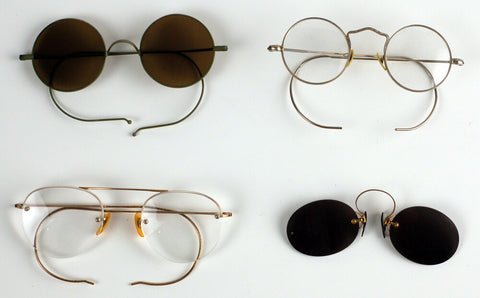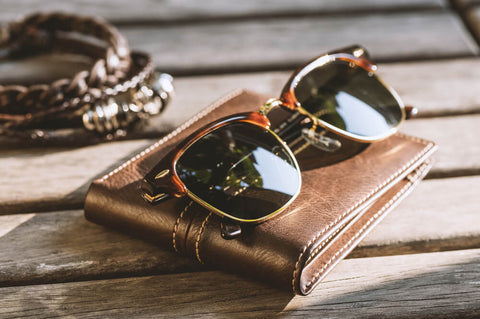Browsing through our wide selection of sunglasses, you might have wondered once or twice about how they are made. You might have also wondered why some pairs of shades are more expensive than others, especially if they look equally stunning. While brand names carry a certain weight, it all boils down to the materials used in the making of your favourite sunnies.
Sunglasses: A History
Let’s talk about why sunglasses were invented in the first place.
Sunglasses were, and still are, a necessity in daily life. This was especially true centuries ago when all work was done on the fields or out on the sea. The harsh brightness of the sun was both a blessing and a nuisance for people of yesteryear.
It is this reason that we had to come up with a protective gear for our eyes. The Inuit people of North America had their version of sunglasses; however, it was anything but. Due to the sun’s reflective rays on the snow, the Inuit fashioned a walrus’s tusk with slits. Though a far cry from today’s Oakleys and Ray-bans, it did its job: it was able to combat snow blindness.

Over the course of time we can see many claims of man creating all sorts of sunglasses. However, it wasn’t until around the 17th century that an optician released eyeglasses with emerald-tinted lenses. It seemed to have been all the rage for some time as it promised to help vision problems. In 1929, Sam Foster began selling mass-produced sunglasses at the Atlantic City boardwalk. Bausch & Lomb soon followed suit a few years later and created sunglasses specially designed for the military — the aviators.
Initially invented to reduce brightness, as our understanding of the sun improved, sunglasses producers began releasing products that were designed to protect our eyes from harmful UV rays, while polarised lenses were invented in the 1930s to combat glare. Sunglasses are essentially made of two parts: the frames and the lenses. Lenses are usually made of coloured plastic and glass while frames can be made of metal and plastic as well.
The Frames
Frames hold the lenses in place and should be able to provide a snug yet comfortable fit. Many brands offer sizes in frames, which is a good option for those who have particularly small or large face sizes. A majority of sunglasses are made of plastic and some sporting metal-based materials. Protecting our eyes with a worthy pair of shades should be considered an investment of sorts, but it doesn’t need to burn a hole in your pocket either.
Plastic
Plastic is the most commonly used material for sunglasses due to its versatility and durability. Another known factor is its cost; plastic is the most affordable material in the market. As expected, the type of plastic used in sunglasses is different from the type used in children’s toys, for example. Zylonite and polycarbonate are both plastic materials that have been used by most brands. Propionate, a nylon-based plastic material, is usually found in sports sunglasses. All these materials are known for taking the heat when things become rough; you know you can count on them to last a lifetime when taken care of properly. Another reason why plastic is the industry’s go-to material is because it is lightweight and easy to carry around.
Metals
Not as common as plastic (but still very much in use) are metals. Metals are as equally as lightweight as plastics, though some may corrode in time. Stainless steel is the most affordable metallic material used for sunglasses and is quite corrosion resistant. Aluminum and titanium are more expensive materials and used by high-end brands. They are both lightweight, durable, and resistant to damage caused by corrosion.

Wood
A less conventional material used to make sunglasses is wood. Wood has been making waves in the sunglasses industry because of its eco-friendly nature in addition to the unique texture and grain of each pair of sunnies. Companies like Gold Coast Longboards breathe new life to skateboards, by recycling them into sturdy, lightweight frames suitable for sunnies.
Lenses
Lenses have come a long way since the first mass-produced sunglasses were sold. They used to be tinted pieces of glass that looked stylish and helped block the sun’s bright rays. As our knowledge of the sun improved, so did the materials used to make lenses. Nowadays most lenses are either made of plastic or glass.
Glass lenses are still quite popular, though there are disadvantages to using them. They tend to be heavier, which can be more uncomfortable on smaller faces. There is the tendency that it might break upon impact, but reputable manufacturers rarely come out with lenses that would do so nowadays.
Polyurethane and acrylic are two plastic materials that are used in lenses. Polyurethane is more high-end of the two, providing optimal protection and vision clarity. Acrylic lenses are the least expensive as they don’t provide as much protection as polyurethane lenses – making them a good option for fashionable sunglasses.
Polarised lenses have been around for many decades now and are a prized feature for most outdoor enthusiasts. Sunglasses lenses are treated with a special coating that cuts down the sun’s glare immensely, making it easier and more comfortable for the wearer as they enjoy sports such as skiing or fishing.

Coloured lenses have been in fashion for decades but in recent years brands have made use of specific hues to bring even more comfort to the wearer. For example, amber coloured frames are best used on the green and for all-weather conditions, from sunny to cloudy; gray for driving, water sports, and other outdoor activities; yellow for target shooting, skiing, and hunting; green for all sorts of activities in any weather condition; purple/red for cycling, racing, snow activities; and blue-coloured lenses for when you go fishing and when it is foggy or misty outside.
Most, if not all, reputable sunglasses release models that are outfitted with lenses which promise to protect our eyes from the harmful UV rays of the sun.
Benefits of Owning Quality Sunglasses
It cannot be stressed enough how important it is to protect our eyes from the sun. While it’s easy to buy a pair of sunglasses from roadside stores, these cheap purchases are most likely knock-offs and probably have tinted lenses that don’t offer UV protection. Great Southern Sunnies offers a wide array of quality sunglasses from different brand names. Regardless of what outdoor activity you intend to do, there is always a style that will fit your needs and budget.
Quality sunglasses offer a layer of protection that knock-offs can’t:
- UV protection: It’s not the eye itself that needs protection, but also the delicate eye area. It is said that around 10% skin cancer has been discovered on the eyelids.
- Lower chances of developing cataracts: One the leading cause of blindness is cataracts. The formation of cataracts in the eye is enhanced with UV exposure.
- Macular degeneration can be prevented: The macula deteriorates over time because of a condition called macular degeneration. This can cause vision to become blurry and may even cause blindness. UV rays can speed up this process.
- Acts as a shield against particles: The wind can carry all sorts of debris like dust particles, sand, and other matter that can cause eye irritation. Wearing a pair of sunnies shields your eyes from irritants.
- All-weather protection: If you think sunglasses are only reserved for summer days, think again. The snow is a highly reflective surface that lets UV rays bounce off of it.
- Polarised lenses provide better vision: Some sunglasses have polarised lenses that cut down glare to a minimum, making it much comfortable for you to look ahead.
- Less wrinkles: Squinting can cause premature wrinkles around the eye area, making a person look older than they really are. Sunglasses, especially one with polarised lenses, lets your facial muscles relax. It makes your time under the sun much more comfortable!

